Thoughts on South Africa

Going to Africa for the first time was a huge step for us and it’s hard to remember how worried we were about the whole thing. Would we have trouble with the languages? Would we be safe? Will the food be safe to eat and the water safe to drink? Should we worry about racism? Civil wars?
In retrospect, I’m very glad our introduction to Africa was through Cape Town. The infrastructure there is good, the population is mostly white, English is spoken by just about everyone… starting at the southern tip really eased us in. Later on, as we progressed through the rest of Southern Africa, things became more difficult for us as travelers, but by then we had gained enough confidence to handle anything thrown our way.
Africa has elements of the Western and Eastern worlds (and even the Middle East), but it’s not really much like either. Africa is its own place, with its own cultures, and its own way of doing business. The list of notes I jotted down on South Africa grew rapidly. As our first introduction to a new continent, there were bound to be many differences from the other countries we’ve visited, not to mention the United States.
Lodging

I was surprised to discover how much changed with respect to the hostel industry when we crossed the Atlantic. No longer were we seeking out “hostels” and “hotels.” Now we were asking after “lodges” and “backpackers.” Our greatest concern in South America, one which we never failed to ask about, was hot water. That was a given in South Africa, but internet access was much less likely to be included in a night’s stay.
In hostels, we looked for Baños privados. In backpackers, we asked after en suite rooms or self-catering. Matrimoniales became doubles. After months in South America, it was like learning a new language.
Except for two things, the rooms themselves were not so different than the labels that applied to them. Instead of having a fitted sheet, sheet, and a woolen blanket on the bed like we were used to, South African hotels provided us with only a fitted sheet and a semi-heavy duvet. Also, practically every bathroom sink had those old-style faucets: Hot on the left, cold on the right. It’s easy enough to brush your teeth with split faucets, but how do you wash your hands when you can’t mix the water? One side’s freezing cold, the other’s blistering hot!
Internet

So, we were finally in Africa and we were looking forward to sharing our new adventure with our friends and family. Right up until we tried to log on. The internet is expensive in South Africa!
To get online at our first backpackers (I still can’t get used to using that noun to describe a hostel!), we had to pay 25 Rand, or almost $4, for one hour. And it wasn’t even a decent connection. Throughout our stay in Cape Town, we struggled to find a good connection in coffee shops, the mall, and other hostels and hotels.
The V&A waterfront mall had free wi-fi, but you had to register and the process was so slow it almost wasn’t worthwhile (I once clocked it at 7 minutes to get past the authentication screens.) We got lucky with our second hostel; it was over a coffee shop that gave out a static password with any purchase. The fastest connection we had was at the Cape Diamond Hotel, but like many of the connections in Africa, it turned out to be a 3rd party provider and you had to buy a voucher with your credit card before you could use it. The $7.50 price tag would have been acceptable if the connection wasn’t capped with a 150MB transfer limit.
And that’s the big difference between the U.S. and Africa when it comes to the internet. ISPs in Africa cap the amount of data you can transfer, not the speed at which you can download. Unfortunately, countries that do business this way will ultimately fall way behind the technological curve in this era of rapid advancement we live in today.
Howzit?
English will get you by just fine in South Africa, but they also speak Africaans. Africaans seems to be about 90% Dutch in origin and, I swear, I could live there for 10 years and still not be able to pronounce half the place names.
Without trying, we learned a few new words, but nothing of note. One that’s almost impossible not to pick up was the common greeting, “Howzit?”
I would have said that’s a simple shortening of “How’s it going?” but sometimes I felt my answer of “Good!” was inadequate. Perhaps it’s a more sincere question, like in some Spanish-speaking countries when they ask ¿Cómo Estás? In the U.S., we don’t really want to know how someone’s doing when we ask, “How’s it going?” but in other countries, the question can be genuine.
Languages
The way our sensationalist media (and even our education system) portrays Africa is a shame. It’s because of those two institution that I had an inherent fear of traveling on this continent. Yes, many of the nations struggle with extreme levels of poverty. Yes, public education is not up to the level that we have in first world countries. But Africa simply blows us away in languages.
There are hundreds, if not thousands of languages on the continent, but I suppose that if you totaled up all the native languages in North America, that number would be impressive, too. No, what blows me away about Africa is that everyone we meet is bilingual. Everyone. Granted, not everyone speaks English very well, but often that’s because it might be their third language!
Languages play an important role in our development as a society, in the way our brains function, even the ways in which we view the world. It makes me wonder how many of the differences I see between our countries can trace their roots back to the fact that everyone in South Africa can understand at least two languages. What would the US be like if everyone – your friends, your family, your neighbors, your politicians — was like that?
Stadiums

If I hadn’t known that the FIFA World Cup had rolled through South Africa in 2010, I would have suspected it anyway. Every major city we visited had a prominent and shiny-new stadium somewhere along its outskirts (or, in the case of Cape Town, right smack in the middle of the waterfront.) Some of the parks surrounding the stadiums looked really nice and I think that South Africans now have some facilities to be proud of. I wish we’d had a chance to see a soccer game while we were there.
Recycling
I would have liked to have seen what Cape Town looked like just a few years ago, before the World Cup. I have a feeling that many of the services we saw while we were there were implemented ahead of the big tourist influx. Recycling may be one of those.
Be that as it may, it was nice to see lots of recycle bins on the sidewalks. Clearly labeled, with places for organic garbage, plastic, and the like. They even had a mascot leading the recycling effort. Zibbi? A Roadrunner or something? I don’t know, whatever works.
Plastic Bags
Most of the grocery stores throughout South Africa only have plastic bags. There’s no option to get your groceries packed away in paper bags. But conservation is a big deal in the country and you can tell they’re doing their best to encourage people to bring canvas bags to the store, or at least recycle their old plastic bags, because they charge you for any plastic bags you use to pack your groceries.
It’s a great idea, actually. Each bag has a barcode printed on it. If you say, “yes,” when the cashier asks you if you’d like a plastic bag, she’ll just tear one off the stack and scan it like she would any of the other products you’re buying.
Plastic bags are always useful – we’re sure to carry a few in our backpacks for laundry, bus snacks, waterproofing bags, etc. – so I like the idea that they haven’t banned them completely. And this strategy is effective, too. Oksana and I would slap our foreheads and say, “dammit!” every time we forgot to bring our own bags to the store!
Panhandlers
We didn’t spend too much time in the big cities – just roamed around small sections of Cape Town, Pretoria, and Nelspruit – but we didn’t notice that many beggars on the streets. On the other hand, we had our fill of panhandlers. They’re synonyms, so what’s the difference? In my mind, beggars stay in one place, panhandlers follow you around.
The worst was in Cape Town. Dozens of times a day we’d be approached by people looking for handouts. Most were tolerable and would move on to other North Face-wearing white people as soon as you said, “Sorry, can’t help you.” Some, however, would attach themselves like leeches and follow you for blocks.
Two examples that stand out in my mind:
1) We were walking down the street, just after dark, and getting close to our hotel. There was a small group of guys in front of us, standing in a rough circle, just talking. When one of those guys saw us approaching, he broke off mid-sentence, took two strides toward us, fell to his knees and started asking us for a handout. When we turned into a convenience store (not to avoid him, we were actually planning to walk in there), he followed us in, pleading for a handout. The shop owners chased him out… whereupon he simply rejoined his friends.
Not hungry, not desperate; just trying his luck with the obviously rich, white tourists.
2) Another time in Cape Town, another street. Again, we were walking back to a different hostel on Long Street, probably the touristiest street in the city. A guy sidles up to me and starts asking for money so he can buy milk and bread for his family. “Sorry, can’t help,” didn’t work on him.
He walked over five blocks with us. I tried to be polite, to tell him our situation as he told us his: We’re traveling for a year, we don’t have any spare money, we don’t have a job either. Oksana even told him that if he really needed food (as opposed to money for alcohol or drugs which seemed more likely), he should seek out one of the charity shelters in the city.
His persistence took on a decidedly shady turn when he leaned in and said, “Come on, man. Don’t make me pull my knife.”
Oksana didn’t hear him, but she was tired of him following us. She looped her arm through mine and pulled me into a nearby shop. As soon as we did, he spotted two more tourists and crossed the street to bother them…
…and then came right back to us when we exited the store! My patience was at an end; I wasn’t interested in being polite any more. “Look!” I said, before he could open his mouth again, “It’s not going to happen!” He left us alone after that.
I decided early on this trip, a trip where every cent matters, that I wasn’t going to hand money out to anyone, for any reason. That’s easy to do when it’s the panhandlers, hustlers, and touts up in your face, but I feel guilty about my decision sometimes when I pass the cripples and the elderly and the infirm on the church steps.
Saturday Night
Saturday night in Cape Town was surprisingly low key. You can, of course, always find a bar to hang out in, but it didn’t seem like things were hopping like they were on a Friday night. Perhaps one of the reasons why is that sales of alcohol – at least in grocery stores and liquor stores – is cut off promptly at 5pm.
I assume this law is intended to make sure everyone is nice and sober for church on Sunday morning. Probably makes it a little difficult to pull together an impromptu hostel shindig, however.
Looking back, I couldn’t tell you if this was a country, province, or city law; we only really noticed things were quieter in Cape Town.
Quality of Merchandise
While there are plenty of familiar brands to be found on the shelves of stores in South Africa, there’s also quite a lot of generic crap. Most of the non-food items in grocery stores (you know, things like house wares, the tiny automotive section, tools and toys) were of a quality well below what I would expect to find in even a Wal-Mart. These are the very cheap Chinese knockoff brands that you’d expect to see in a dollar store.
Of course, these are also the things the average person in South Africa can afford, so it’s what the store stocks on its shelves. Unfortunately, it’s a poverty trap. These items are so cheaply made, a person might go through four or five of them (and end up paying more in the long run) than if they bought one well-made, quality item instead.
Medicine

When browsing through the medicine shelves at the larger supermarkets, I was surprised to find them very lacking. Headache medicine and sore throat drops, that’s about it. Oh, sure, they have different brands and different things like ibuprofen, aspirin, and maybe Tylenol. But if you go looking for cough medicine, nasal decongestants, sleeping pills, or any of the other stuff you’d find on a typical grocery store shelf in America, you’re out of luck. (To be fair, I’d guess most of that stuff is available at a pharmacy.)
Sadly, the stuff that fills in the rest of the shelf is more depressing. Three-quarters of the items fall into what I would classify as homeopathic remedies, vitamins, and out-and-out snake oil. Even the brands that, by their ubiquity seem to be quite popular, look like they’re straight out of the 19th century. Grandpa’s Headache Powder? APPLY DIRECTLY TO THE HEAD! No thanks.
I also noticed billboard advertisements that encouraged self-help solutions for serious medical illnesses. Hard to say for sure, but I got the impression they were some sort of anti-insurance schemes that prayed on ignorance. Made me wonder if things like shamanism were still widely practiced in South Africa.
Boogers
I hesitate to bring this up because it probably crosses that “too much information” line, but…
I noticed once we left the coast that the mucus generated by my nose went a little crazy. Now, if you don’t count fainting from high altitude, shivering uncontrollably from a fever, or vomiting and diarrhea from food poisoning, I can honestly say I haven’t yet been sick on this entire trip! It wasn’t a sinus cold, is all I’m saying.
No, I think it was the Kalahari Desert. Away from large bodies of water, the air in southern Africa dries out completely and a lot of dust is always kicking around. My nose paid the price.
I never had any real trouble breathing, but by the end of the day, there would be huge amounts of flakey, crusty snot stuck inside my nostrils. The kind you can’t rid yourself of with a quick blow into a tissue. The kind that’s immensely satisfying to pry out with a fingernail. Nights were rough. Sometimes my snoring would wake me up (or Oksana would wake me up because I was snoring) and it was all because of the altered airflow through my nose. Mornings had a new routine besides brushing my teeth.
I couldn’t figure out the dry nose thing for the longest time. It wasn’t until it disappeared in Botswana, when we spent a few days surrounded by water again on the Okavango Delta, that I figured out what was causing it.
Transportation

The buses weren’t all that bad, but they were not as nice as they were in Peru, Chile, and Argentina. Reclining seats, some temperature control, and movies to watch as you rolled across the countryside. Actually, the movies were pretty bad.
In South America, you can put money on there being a movie with Schwarzenegger, Van Damme, or Chuck Norris-with-a-sidekick-dog on your bus. In South Africa, it’s likely to be a low-budget, straight-to-DVD religious movie with heavy-handed morals.
For what it’s worth, I commend these family-run bus companies for choosing to play what they consider to be movies with high values, but the movies themselves? They’re terrible! Some of them have actors you’ve seen before; the ones that have fallen so far from the A-list that there’s no going back and now they’re working to pay the bills. Others are hacks that will forever aspire be D-list actors… and with one line reading, you can tell they’ll be lucky to get that far. The good actors are phoning it in and the bad actors would be better if they’d just do the same.
Every Christian movie we saw was painfully hard to watch. It was the very definition of preaching to the choir, too. People who already share the faith will find comfort in the morals presented in these movies and the people who aren’t religious will resent being trapped on a bus while being beaten over the head with them.
Give me the Terminator any day.
Censorship
Speaking of religious undertones, I thought it interesting to see how censorship played on TV. Any time the word “God” was used in even a slightly blasphemous manner, it was bleeped out, but words like “shit” were left right in. Not a big deal to me, but interesting to think how much more influence the religious right have, at least with respect to the media, in South Africa.
Taxis
We were only in South Africa for just short of five weeks, so you shouldn’t expect me to be able to tell you how to hail a taxi.
We were told by one hostel owner in Nelspruit, “It’s not like the United States; you can’t just put your hand out and expect a taxi to stop. You have to know someone!”
We just thought he meant, “You have to call a taxi,” but no. I think he meant you really need to know someone!
Best we can figure: In many places, there are no such things as taxi companies. That means you won’t see any cars on the street with lettering on their sides or lighted bubbles on their roofs; you won’t see a row of parked yellow cars outside places like malls, bus stations, and parks; and there’s simply no dispatcher you can call to have the nearest taxi delivered to your door.
Instead, a person with a car can apply for a permit that allows them to sell rides to other people. (Which is all a taxi really is, I guess.) For a tourist, though, it’s impossible to tell whether a person is licensed or not without actually asking them to whip it out and show you.
When Oksana and I found ourselves leaving a mall after dark, we asked a security guard where to find a taxi. He told us to walk up the embankment to the freeway, “find the place where everyone’s waiting around and someone will eventually stop for you.” Thanks, but no.
Oksana walked into a nearby hotel and asked at the reception desk if they’d be so kind as to call a taxi for us. Sure, have a seat; we’ll let you know when it gets here!
We’re pretty sure that the guy that showed up a few minutes wasn’t licensed, but rather he was more likely the receptionist’s buddy. We were a leery when we realized there was another passenger sitting up front with him, but we decided that a nice 4- or 5-star hotel probably wasn’t going to call someone to mug us. I’m glad we took that ride, too, because we had a fascinating conversation about South Africa with the passenger that continued for five minutes after we arrived at our destination!
Fortunately, the owners of most backpackers will know one or two of these drivers-with-licenses and they can call them when you need a ride. Otherwise, you’re walkin’.
Driving
First, I should point out that they drive on the wrong side of the road in South Africa. That’s the British influence, I imagine. It has wider repercussions than you might think. Firstly, to avoid dying, I had to remind myself what my parents taught me as a little boy: Look both ways before crossing! I can’t count the number of times I stepped off the curb, looking the wrong way.
You get used to that in time. What’s harder to remember is that people tend to walk in the same “lanes” on the sidewalk or in hallways. We often found ourselves swimming against the stream.
When we discovered that renting a car would be the best way for us to get around, I decided that I had to conquer my fear of driving on the “wrong” side of the road. We did everything we could to ease me into it, but that first day was still terrifying.
Forget about the rules of the road, there were questions I had about the car itself! For instance, since I now had to shift gears with my left hand, would the gears be in the same positions, or would first gear now be next to my left knee? For that matter, are the clutch/brake/gas pedals in the same position? What about the turn signals and wipers?
(For the record: First gear is in the same place (always on the left side of the car), the pedals are the same, and there’s no standard on which side the turn signal resides. I’m not the only one in South Africa that cleaned his windshield when he was about to switch lanes!)
I spent a good 15 minutes in our rental car before we dared move from the parking space, mentally practicing the mechanics of driving our VW Polo Bizarro-car.
Finally, we eased out of the Hilton car rental lot and turned onto one of Cape Town’s main thoroughfares. It was late Sunday morning, however, and there were few cars. I had studied the map like there was going to be a final exam and knew I had only to negotiate one intersection before we got on the N2 highway on our way to the Garden Route. If I could make that, it would just be a matter of staying in our lane for the next few hours…
Everything took getting used to. Exits were on the left. When there were multiple lanes, the fast (passing) lane was on the right. The worst were the roundabouts. Off the freeway, on the outskirts of towns, they were plentiful and at first I had to concentrate so hard that I would ask Oksana to turn off the music when we approached them.
- Slow down
- Read the sign, which exit am I taking?
- Remember to go counter-clockwise!
- Watch for other cars
- Inner or outer lane?
- Shit! Don’t forget to downshift!
I always forgot to downshift. I couldn’t seem to hold that in my mind with everything else. We never stalled, but sometimes we lurched pretty hard.
Despite all that, we made it to Gansbaai late that afternoon with only a couple sweaty palm prints on steering wheel. We spent the next three days in that small town and driving around those sedate roads gave me the confidence to make it the rest of the way to Pretoria without too much adrenaline flooding my system.
So things I liked. The South African freeway system does exits well. As you approached each one, there would be a series of three small signs along the left-hand side of the road. The first with three painted bars, then two, finally just one bar. An easy way to see how far ahead the exit lies, especially if you’re approaching a big jumble of freeway on- and off-ramps. When there were multiple lanes of traffic, they also changed the white lines between the lanes as you approached. Instead of just a dotted white line to indicate your freedom to switch lanes, there was a solid line painted on the right. If you can’t visualize that, it meant that you were free to switch lanes away from the exit, but not towards it. Hopefully that cuts down on the aggressive drivers that cross 2 or 3 lanes of traffic, at the last minute, to make their exit from all the way over in the fast lane.

Over time, we puzzled out some of the unofficial rules of the road in South Africa, too. For example:
It’s perfectly acceptable, if illegal, to drive completely on the shoulder (what we’d call the emergency or breakdown lane) for miles and miles. Usually, when we drove up on someone’s tail, they’d just ease right over, still going 60mph or so, and let me pass. After awhile, I grew comfortable enough to try it when people started tailgating me. We also learned that it’s polite to give two or three flashes with the hazard lights once you’ve passed someone in this manner. After all, they just illegally drove on the shoulder so you could get by… Might as well thank them for it!
You have to be careful sometimes with that shoulder driving, too. Sometimes there are roadside vendors standing there, especially near the cities. I would have expected to see small wooden stands, perhaps a table with fruit on it. Nope. More often it’s just a person standing there holding out a bag of oranges or a dead chicken. We never bought anything.
Mileage
Is it possible that I’ve never driven a car that was manufactured for a market that uses kilometers before? Perhaps it’s just that I’ve never been in one with dashboard computer. Anyway, I never realized until now how there’s no real analogue to our MPG rating, or miles-per-gallon.
Think about it. Can’t use kilometers-per-gallon, because gas is sold by the liter. So, kilometers-per-liter, right? Well… a liter’s only about one-quarter of a gallon, so the numbers won’t look very impressive.
Let’s use an example: Say your car gets 40 miles-per-gallon. That’s a pretty good selling point, right? Well, convert that to liters and it’s going to be 10½ miles per liter (40 ga * 3.8 l/ga). Not as impressive on magazine spread.
Our dashboard readout gave us an entirely different way to look at gas consumption. It read “6.1/100km” or 6.1 liters of gas consumed every 100km. I had to do the math on both numbers to have any idea whether that was good or bad; turns out it’s 37.38 miles per gallon.
Parking

I’m glad I waited until we were ready to leave Cape Town before we tried renting a car. I don’t think I would have been able to figure out the parking there.
Cape Town has Parking Marshalls. Each block has four of them, one covering each street. They wear official looking reflective vests, hang around all day, and generally take the place of parking meters. They perform a couple dubious functions (helping people parallel park, stopping traffic to let them out) and one vital one (keeping an eye on your car.)
They’re not police, so I doubt if someone really wanted to jack your car that they would do anything about it, but with one marshal watching each block of the downtown area, I suspect most cars are fairly safe during the daylight hours. They don’t work after dark, of course.
What does it say about the car crime rate when a city puts four people to work on every block, though?
We rented a car to drive the Garden Route and we got the hell out of Cape Town as soon as possible. For the most part, we avoided the bigger cities.
Although I didn’t see any official parking marshals in the other towns, we did see their unofficial analogues in just about every supermarket and mall parking lot. Officious looking people — sometimes with apron pockets full of jingling change, sometimes with matching hats and vests – standing around those big lots all day and directing traffic to the best parking spaces. Conceivably, they keep an eye on your car for you, too, while you’re off doing your shopping. In return for that, plus directing you out of your parking space with large gestures as if you were a 747 pilot pushing across the tarmac, they hope you’ll throw them a few coins.
Oksana and I never did – I don’t need anyone to show me how to back up! – but we felt guilty driving off every time. At least until we asked some South Africans about the situation and found that the locals never tip them either.
Turns out, very few of these parking enforcers are employees of the store. Often, they’re just homeless (or at least jobless) people that have staked a claim on a parking lot. Sometimes people get territorial and fistfights break out. Seems like there should be a better way to make a living.
Robots
In South Africa, they call “stoplights,” “robots.” Getting directions before we knew that little tidbit was interesting.
“Turn right at the parking lot exit, then drive across the bridge. After you pass the robot, you should be getting close.”
“The robot.”
“Yep. Ask someone after the robot.”
“Okay. Yeah, sure. We’ll do that.”
Carrying Things on Your Head
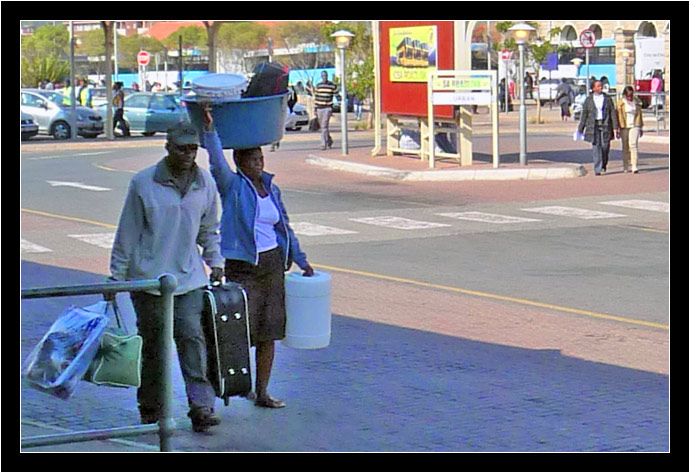
The first time I saw a woman walking down the street, balancing a huge basket of fruit on her head, I remembered all those fascinating filmstrips about Africa I’d seen in grade school. I vaguely recall going out to the playground with my friends afterward and trying to walk around while balancing things on our heads. I hadn’t thought about that for at least thirty years.
As we traveled through Africa (not just South Africa), we saw it again and again. Baskets of laundry, building materials, buckets of shells, giant bundles of sugarcane. I even saw a guy (with help) balance two monster suitcases on top of his head before setting off for a ferry.
In the States, we’re told that carrying a backpack – even sitting on a too-thick wallet! – can cause back problems later in life. What must the incidence of back or neck injury in Africa be like? Or could it be that the core strength and balance necessary to carry heavy loads on your head can actually end up protecting your spine, as you age? What are the long term physiological effects of carrying heavy loads this way? More than anything, I wanted to ask the opinion of an African doctor specializing in arthritis or spinal problems.
Apartheid
I guess you can’t talk about South Africa without talking about apartheid. Apartheid, if you didn’t know, were laws put in place to keep blacks and white separated in South Africa. It was abolished in the 90s, to worldwide headlines, but its effects are still quite visible today.
One could write a doctoral thesis on how South Africa is dealing with the after effects of apartheid and I could probably double the length of this already-long blog post with just my own observations. I’m not sure I can organize my thoughts that easily, however, so I’m just going to use some bullet points:
- 90% of the country is black and now they’re in the ruling majority. Unfortunately, the memory of apartheid runs deep and we heard from both sides of the racial divide that those in power now feel a strong sense of entitlement due to the suffering they lived through.
- South African citizens (both blacks and whites) that want to see their country become a first-world nation admit that it will not and cannot happen until the current crop of politicians “age out.” That is, those that lived through apartheid will never be able to be open-minded about true racial integration. Once a new generation of politicians is elected – ones that grew up in a world after apartheid – that’s when we’ll start to see significant change. (Even so, there are young blacks today that demand entitlements from whites, playing the apartheid card even though they were born after it ended.)
- There are three divisions in the society: Black, white, and colored. None of the three identify with the other two, though the coloreds and the whites are political allies of sorts right now and with each election since apartheid was abolished they’ve been gaining at the polls, chipping away at the black majority.
- Whites are very much in the minority and yet they are still the ones with most of the wealth. You can certainly see that in the tourism sector. Practically every establishment we gave money to, be it travel agent, safari lodges, or hostel owner was owned by a white person. Plenty of the employees were black, however.
- Reverse-racism (if you believe in such a thing), is a fact of life now. Many black leaders drum up support in politics with campaigns that amount to little more than “don’t let the white man back into power” and many white people we talked to expressed their frustration with trying to get anything from a government agency.
(A note on “reverse racism.” Some people believe that if you’re in the oppressed minority, you can’t be called a racist for stereotyping the controlling majority. That’s bullshit. It doesn’t matter if you, yourself, are being discriminated against. Any time you make an assumption about someone based on their color of their skin, or the group they belong to, you’re a racist.)
Townships
Townships are a direct result of apartheid. It seems like every major town or city has one and they’re horrible. Picture this: You drive into Cape Town or Port Elizabeth or some place and look around. There are bustling businesses, paved and lighted streets, maybe a nicely green college campus. Then, as you drive around a hill or a small forest, you come across a township, a conjoined twin of a city, ugly and deformed.
Let’s not sugar-coat it: Townships are slums. During apartheid, blacks were segregated and forcibly removed from the nicer areas of town and into these slums where public services are scarce and jobs and money even scarcer. Today, the divide isn’t black and white, it’s economic, but it may as well still be racial. The black residents of the townships have been there for generations, and education (and along with it, ambition, aspirations, dreams) have been as hard to come by as electricity, water, and sewer.
There are many organizations trying to help. We met student volunteers from other countries, doctors, even construction companies that have donated materials and expertise to build new houses in the townships and give them away in a sort of lottery system. Unfortunately, by doing the work for the township residents and essentially giving the houses away for free, it only adds to people’s sense of entitlement. Why should I work hard for a better life if I can get the same thing by waiting long enough?
The townships were very disheartening and my mind kept trying to find ways to fix the system. Even as a hypothetical mental exercise, I could come up with no easy solution. I think the only thing you can do is try hard to get the kids in school, keep them there, and let them know that through education they can lift themselves out of the slums. It will take generations, though, to make even make a dent.
Trailers
No, we’re not still on the topic of low-rent housing. I’m talking about movie trailers! What’s the deal with them in South Africa? Every movie we went to had the normal amount of previews showing before it, but almost all of them were so damaged that they were hard to watch. Scratches danced so badly over the whole screen while they played that I could only assume the projectionist lovingly cleans them with 300 grit sandpaper before every showing. Fortunately, the movies themselves were fine.
Crops
We didn’t spend a ton of time driving through farm country, but I did see the occasional field at times. Two things struck me: The first were the huge stretches of dead corn. Brown and dried to a crisp, they stood by the roadside for miles. I’ve never seen anything like that in corn country U.S.A., so it took me awhile to guess what might be going on. When labor is so cheap, it doesn’t make sense to pay for large harvesting equipment. Instead, field hands had probably plucked off the ears long ago and then turned off the irrigation until the next planting season.
The second were the large field fires. Sometimes we would pass blackened fields that reminded me of the slash-and-burn agricultural techniques used in the jungle… only without the slash. We drove past whole fields of wheat with tall walls of orange flames advancing through them. No one in sight, no fire control measures that I could see. Just huge fires burning through the fields, hot enough to feel through the closed windows of our bus.
I never thought about it much before traveling, but it seems obvious now: Farming is different the world over, taking its shape from the local weather, geography, and socioeconomic conditions.
Bread
In practically every grocery store in South Africa, bakeries sells loaves of freshly baked bread… but they don’t slice it for you. If you would like your bread sliced, you simply take it out of its plastic bag, walk it over to the dishwasher-sized bread slicing machine, turn it on, and watch the lurching, vibrating beast go to work on it.
Basically the bread is bounced around and pushed through rows of thin piano wire. When it comes out the other end, there’s a handy chute you can thread your bag over so you can slide the newly-sliced bread back into it.
Usually this contraption is all the way up by the entrance of the store, where people chop their bread up after paying for it in the cashier lanes. In the States, it would be back in the bakery, operated by the employees behind the counter. Honestly, I can’t imagine how these things don’t separate curious South African kids from their fingers.
Food

Oh, there was so much to love about South African food! I’m a big fan of meat and grills, so I was delighted to find a strong barbeque – or braai – culture there.
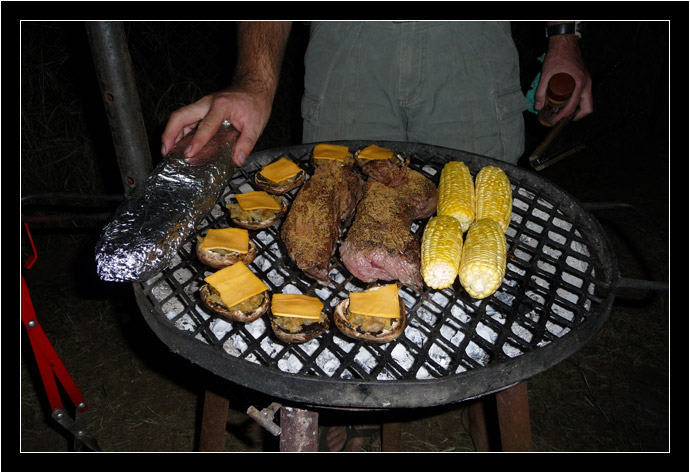
While a braai is much the same as a backyard BBQ back home, there are a few things that set the South African traditions apart. The grills are different and they typically cook on wood coals, but that’s minor. One thing I’d love to take home, though, was the cast-iron kettles they sometimes put on top of the grill. How else would you “BBQ” a whole pot roast stew?

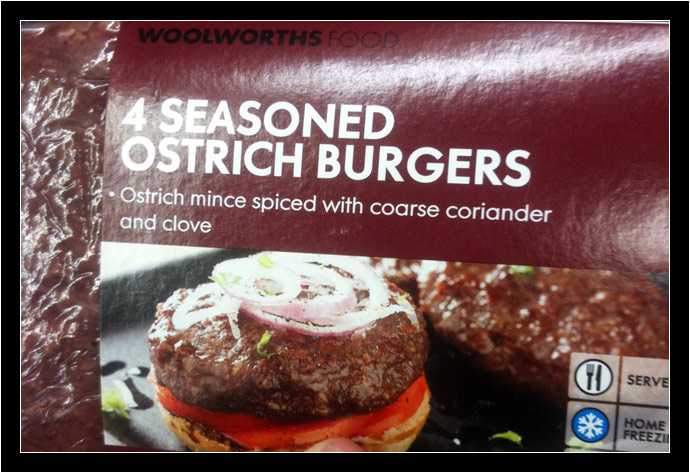
The meat section of every grocery store has all sorts of things worth trying. In addition to things you just don’t see very often in the States, like ostrich steaks, they have a bewildering assortment of sausages or boerewors. Think of how much Americans love to roast hot dogs over a campfire. That’s how much South Africans like their sausages.
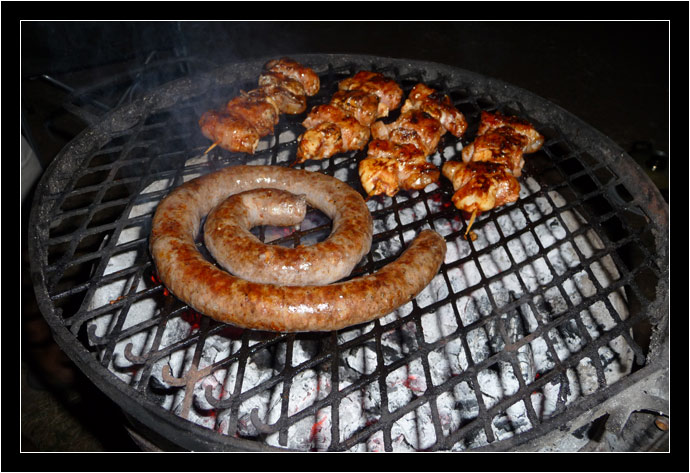
If you need any proof of the size of the braai culture, all you need to do is walk down the BBQ sauce section of the supermarket aisle. Flavors you can try are: Spicy, Tikka, Sweet Chili, Peri Peri, Prego, Rave, BBQ, Garlic, and Monkeygland. I tried monkeygland. Just tasted like BBQ sauce to me, but for all I know, that’s what monkey glands taste like!

Going hand-in-hand with the braai, there’s also a fantastic range of jerky, or biltong. And not just in beef or chicken or something normal like that, oh no! You can get kudu or buffalo or ostrich if you want. Oksana and I looked for bundles of sausage jerky (or dry wors, as they were called) every time we stopped by the store. On our safari, we learned that a cold Coke pairs with spicy chili kudu biltong like mom and apple pie back home.
Of course, South Africa is also known for its wines, but after Argentina, Oksana and I didn’t go out of our way looking for bottles. Instead, we pursued another vice – Hard ciders. Seemed like every cooler with beer inside would also have shelves and shelves full of apple ciders. There were many to choose from and we had a great time finding our own favorite brands and flavors.

And speaking of drinks, South Africa was full of just about the only thing out there that could tear me away from my Diet Coke addiction: Ginger beers. Non-alcoholic, with a sharp ginger bite, they’re much stronger than your average Canada Dry ginger ale and I think that if they’d had caffeine, I’d drink nothing else ever again. I liked trying out the small local brands, but more often we just picked up a nice, big 2-liter bottle of Stoney’s, bottled by none other than the Coca-Cola Company.
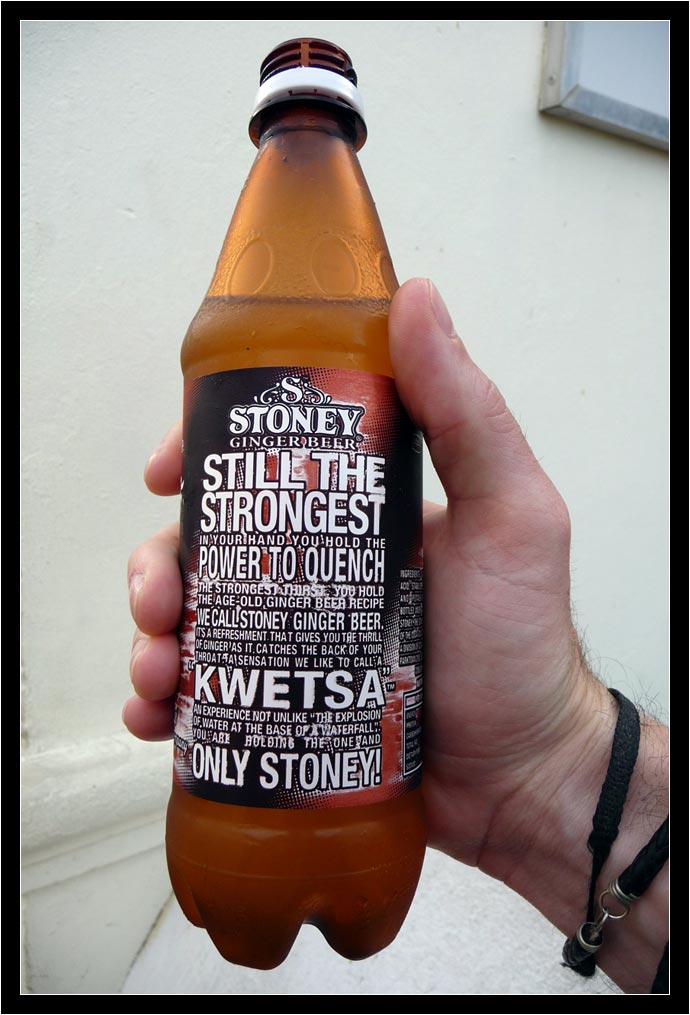
Biltong, ginger beers, hard ciders, boerewors and braais. Man, I’m ready to go back!

Great observations! I’ve taken your advice and started doing the same. When I get home, or perhaps on my endless hours on a number of planes before I get home, I will start to jot it all down in blog-publishable form. A couple of comments:
– Language as an intelligence quotient = very interesting conclusion. I will use this in my massive paper that I will be writing when I get back to school and reality as I have not known it for the past 4-months.
– I must dispel your “good values/family friendly” bus movie theory. On our way to Kasane, we were privy to My Bloody Valentine (I think that’s what it was anyway), full of nudity, profanity, and to top it all off, murder of the most grotesque variety. I suppose, however, that it could be a Botswana thing rather than an SA thing.
– I too thought that Botswana was progressive in terms of minimising waste by making one pay for plastic bags at the check-out until I realised that it wasn’t actually a waste management initiative at all. In fact, it’s a money issue. The stores have to pay for the bags so they make you pay; that’s the real bottom line as depressing as it is. The abundance of garbage absolutely everywhere else and the lack of a proper household recycling program led me to that conclusion here in Bots anyway.
– I feel the need to share with you what I have been told by many people who drive on the “wrong” side of the road. It isn’t the “wrong” side of the road just because it’s not the side of the road that Americans and Canadians (and others, of course) drive on. It’s just the “left” side of the road.
This was, of course, my favorite blog post of yours because I can relate to pretty much everything you mentioned here. I hope your travels are going spectacularly!
Thanks for your input, Brandy! Good insights.
I’ve already finished typing up my Thoughts on Bostwana post (and I’m almost done with our skimpy Thoughts on Namibia post, too; we were only there for one day!), but I’m going to wait until next Monday to post it. Since we’re taking time out in Bulgaria, I’m going to try to get caught up on my countries. 3 down, 6 to go!
I’m curious to know which bus company you were on that had the violent movies. I’m guessing it wasn’t Intercape, which was the company that took us from Pretoria to Gabs. I get the impression that Intercape is still a family-run business and it’s the family’s moral values that dictate the cinematic entertainment choices.
Oh, and when I say it’s the “wrong” side of the road, I’m doing that with my tongue firmly in cheek. Sorry if that wasn’t clear. 🙂
No, not Intercape which I did realise while writing that comment. We were on the Gaborone-Lusaka Express, likely not family owned. Lucky for us, the television was broken when we took Intercape 🙂
Yes, tongue-in-cheek was assumed, I just couldn’t resist.
Can’t wait to see the Thoughts on Bots!
A hi-jacking hot spot sign?! Crazy!!
I have a friend from South Africa, and he talks about braiis all the time. I have to think it beats the Argentine asado.
You know, I don’t think we even knew that the hijacking sign was there when we took that photo. (We weren’t driving. We were getting a ride to Kruger with our safari company.)
As for whether a braai beats an asado? Hoooo, that’s a tough one! And we even got to try them back-to-back, too. Hmmm, well, I’m not going to say one is better than the other. I can tell you this, though: We’ll be incorporating elements from both when we one day have backyard BBQs again in the States!
This post is making me hungry!
Loved reading your blog. I’m originally from Durban, South Africa and had to laugh when I read “Grandpa’s Headache Powder? APPLY DIRECTLY TO THE HEAD! No thanks” – it’s actually taken orally. Another thing, we South Africans often eat something called a ‘bunnie chow’ where half a loaf of bread is hollowed out and filled with curry or desired filling thus the unsliced bread. South Africa is improving slowly but most people are stuck in that poverty mentality, sad really, Nkosi sikeleli Afrika.
Jayleen,
Thanks for filling me in! I believe I had that bunnie chow at some point on the trip, so that makes total sense that they sell unsliced bread for it. And I was sort of kidding about the headache powder. I mentioned it by name mostly because that was the only medicine I had taken a photo of. (Also, there’s a truly terrible commercial in the States for some sort of headache relief medication that I was parodying when I wrote “apply directly to the head!” http://www.youtube.com/watch?v=cabyAxhqLh8)